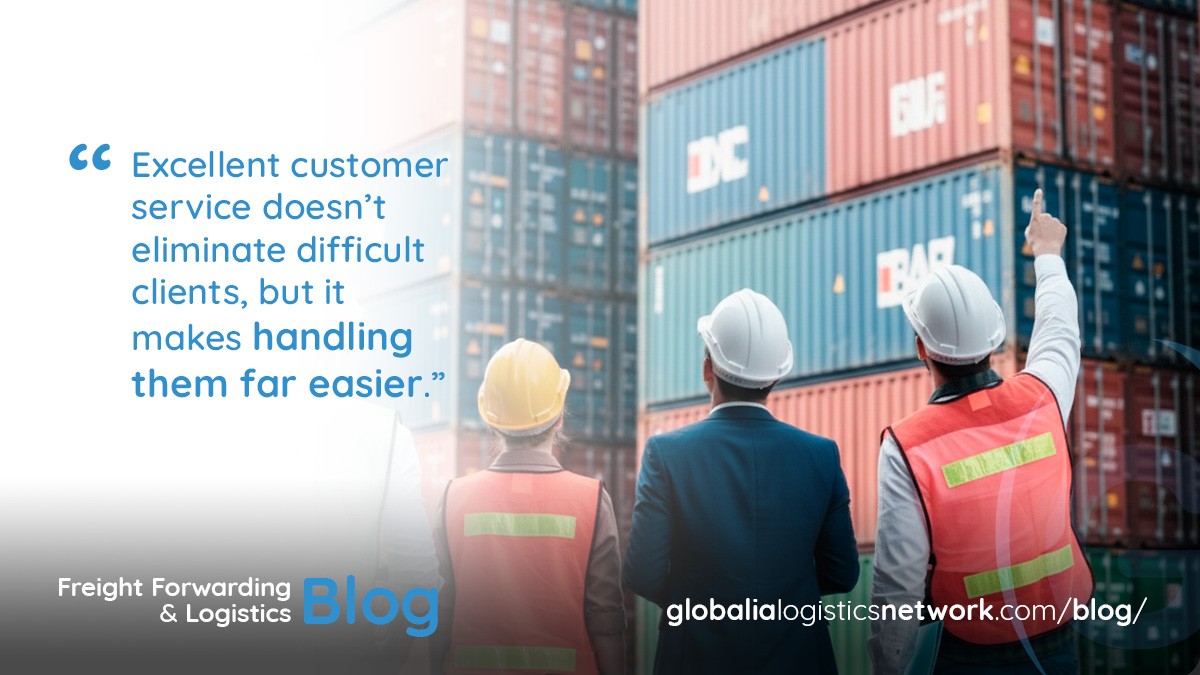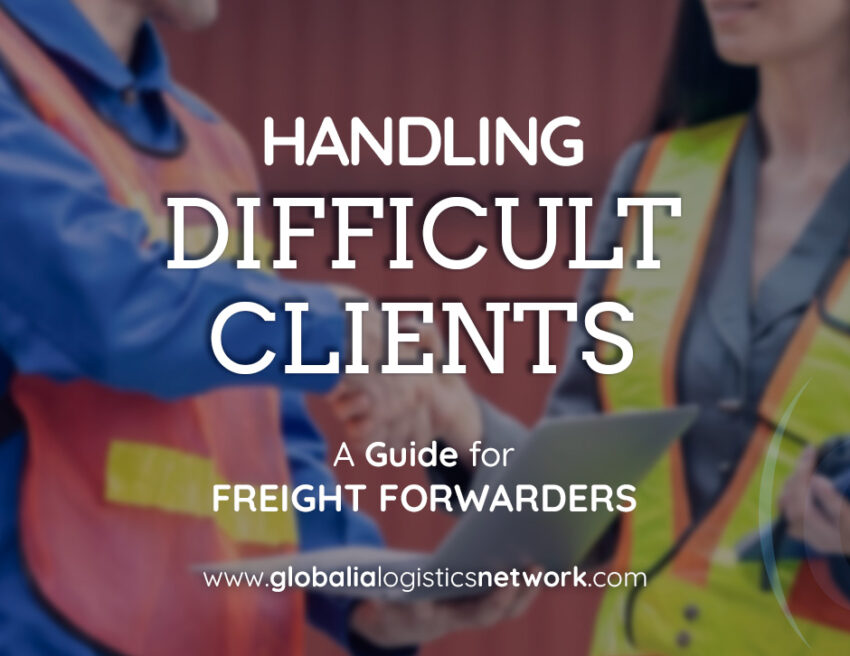Every freight forwarder has that one client. The one who calls at 6 a.m. demanding to know why their container hasn’t magically cleared customs overnight. The one who emails fifteen times a day, each message marked “urgent.” Or the one who believes that “door-to-door” includes carrying the shipment up three flights of stairs. Dealing with difficult customers in logistics isn’t just part of the job, it’s almost a rite of passage. But here’s the twist: those tough situations often highlight the true value of your service.
Freight forwarding is built on precision, timing, and regulatory knowledge, but at its core, it’s also built on people. Clients bring expectations, stress, and sometimes impossible demands. How you manage those relationships determines whether you’ll be viewed as just another service provider or as a trusted partner who can weather any storm. And that’s where the art of customer service in freight forwarding comes into play.
Why Some Clients Seem More Difficult Than Others
The logistics world is full of pressure. Clients are juggling deadlines, production schedules, and their own end customers breathing down their necks. When something doesn’t go as planned, delayed vessels, sudden customs inspections, or strikes at a major port, you’re the first person they call. Often, their frustration isn’t really about you. It’s about the ripple effect that one small delay can have on their business.
For freight forwarders, understanding this context is crucial. It’s easy to take criticism personally, but difficult customers are usually revealing how much they depend on you. Their frustration is a sign of how critical your role is in keeping their supply chain moving. The real challenge is managing those emotions while still delivering solutions.

Customer Service in Freight Forwarding
Here’s the truth: excellent customer service doesn’t eliminate difficult clients, but it makes handling them far easier. Customer service in freight forwarding is not just answering phone calls politely. It’s about being proactive, honest, and consistent. When you build a foundation of trust, clients are more forgiving when things don’t go perfectly.
Take for example, a delayed air freight shipment. If you wait until the client calls you in a panic, the relationship is already on shaky ground. But if you reach out first, explain the issue, provide alternatives, and update them regularly, you transform a potential conflict into an opportunity to showcase your professionalism. Good communication turns problems into proof of reliability.
The Power of Listening
Sometimes, the best way to handle a difficult customer is not to talk at all but to listen. Freight forwarders are trained to solve problems quickly, but jumping straight into solutions without acknowledging the client’s frustration can backfire. People want to feel heard before they hear the fix.
When a client complains, give them space to vent. Then, repeat back their concern to show you’ve understood. Only after that should you lay out the options. This simple act of active listening can turn down the emotional temperature and pave the way for a constructive conversation. It shows respect, which is often what the client was looking for in the first place.
Transparency Builds Stronger Freight Forwarding Client Relationships
The temptation to sugarcoat bad news is strong, especially when you’re dealing with someone who’s already upset. But in logistics, half-truths are more dangerous than the full story. If customs clearance is going to take three more days, say it upfront. Don’t promise tomorrow if you can’t deliver.
Transparency is the backbone of strong freight forwarding client relationships. By being honest about delays, costs, and risks, you position yourself as a partner rather than a vendor. Most clients can accept problems as long as they’re not blindsided. And when they see that you’re willing to be upfront, their trust in you deepens.
Difficult Clients as a Test of Professionalism
Every freight forwarder knows that difficult clients are inevitable. The real question is how you respond. Do you get defensive, avoid their calls, or push the blame elsewhere? Or do you treat the situation as a chance to demonstrate your reliability under pressure? Handling difficult customers in logistics requires patience and professionalism. Each encounter is a test of your ability to remain calm, communicate clearly, and provide realistic solutions. It’s not glamorous work, but it’s the kind of work that builds your reputation. Clients talk, and if they see that you kept your cool during their crisis, they’re far more likely to recommend you to others.
Managing Client Expectations in Logistics
One of the best ways to avoid constant conflict is to set expectations early. A lot of client frustration comes from assumptions that were never clarified. Maybe they assumed sea freight takes a week when in reality it takes three. Or they expected customs clearance to be automatic, when in fact they knew it could face delays. Managing client expectations in logistics means taking time at the beginning of the relationship to explain processes, timelines, and risks. It’s better to under-promise and over-deliver than to leave customers disappointed. Clear expectations reduce misunderstandings and prevent difficult conversations later on.
When to Draw the Line
Not every client is worth keeping. Some are perpetually rude, abusive, or refuse to respect boundaries. While the goal is always to provide excellent service, there are cases where protecting your team and resources comes first. Letting go of a toxic client may feel like a loss, but it often frees you to focus on clients who truly value your expertise. The art lies in knowing the difference between a stressed client who just needs reassurance and one who will never be satisfied no matter what you do. Freight forwarders must balance empathy with practicality. Sometimes the best customer service you can provide is politely saying no.
Turning Difficult Clients into Loyal Customers
Here’s the upside: when handled well, today’s difficult client can become tomorrow’s most loyal customer. If you manage to guide them through a stressful shipment with calm professionalism, they’ll remember. They’ll also know you’re the kind of forwarder who can handle pressure.
Trust is often forged in tough moments. The client who once doubted you may become the one who insists on working with you for every project cargo or urgent air freight shipment in the future. This transformation doesn’t happen by accident, it’s the direct result of consistently providing customer service in freight forwarding that goes beyond the transactional.
Final Thoughts
Freight forwarding is not just about moving boxes, containers, and pallets across borders. It’s about managing people’s expectations, stress, and business pressures. Difficult customers in logistics are part of the landscape, but they don’t have to derail your operations or your morale.With strong communication, transparency, patience, and the ability to set clear expectations, freight forwarders can turn conflict into trust. Customer service in freight forwarding is the secret weapon that transforms tense conversations into opportunities.
At the end of the day, you can’t control the weather, port strikes, or customs delays. But you can control how you respond to your clients. And that response often makes the difference between being seen as just another forwarder or as a long-term partner who can be trusted when it matters most.


